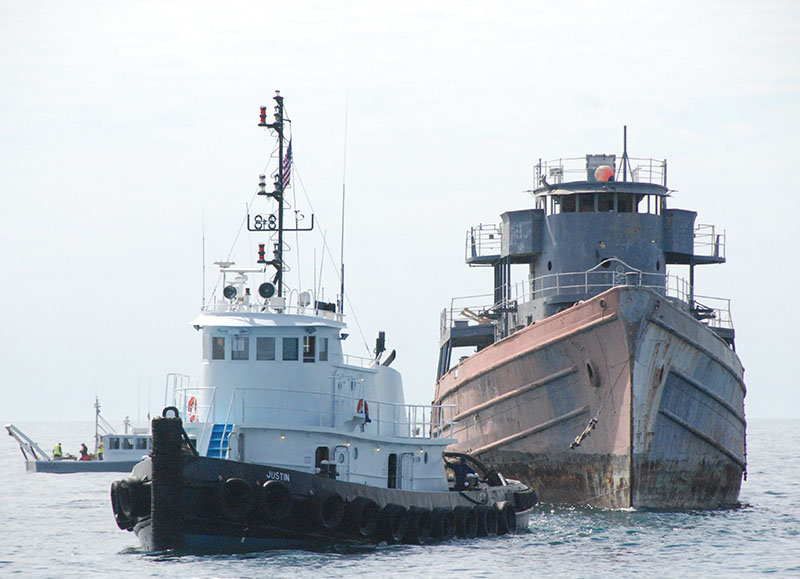The 205’ Coast Guard cutter Tamaroa, famous for its rescue of sailors and downed aviators during the great Northeast storm of Halloween 1991, is on its last mission — 120’ down off Delaware Bay.
Former crewmembers joined fishermen and state wildlife workers from Delaware and New Jersey to witness the old cutter’s sinking on the Del-Jersey-Land Inshore Reef, an artificial fish haven 26 miles southeast of Cape May, N.J.
Originally the World War II Navy fleet tug Zuni, the vessel’s earliest fame came from supporting Marines during the 1945 battle for Iwo Jima, and rescues of hundreds of sailors in the Pacific. After its postwar transfer, the Tamaroa served the Coast Guard for 48 years performing search and rescue, fisheries patrols and saving migrants at sea.
In its final deployment, the Tamaroa is still serving the nation’s marine resources. Obsolete ships, rock from harbor dredging projects, even subway cars and military tanks positioned on reef sites are soon colonized by marine life and attract fish.
Upon its retirement in 1994, the Coast Guard donated the Tamaroa to the Intrepid Sea, Air & Space Museum in New York City, and former crewmen organized to restore the cutter. Work was underway in Virginia when a 2011 storm flooded its engine room and restoration became impossible.
“Some guys wanted to make a museum out of her but it cost too much. I think they needed $1.5 million to fix the keel,” recalled Rollie LeDoux, of Pocono, Pa., who served as a machinery technician on the Tamaroa in the 1970s. “It’s better this way than to see her get scrapped, cut up for beer cans.”
The reef site was established 10 years ago specifically for large ex-military vessels, including the 563’ Navy destroyer Arthur W. Radford, the biggest ship to be sunk on an East Coast reef site. The offshore location is jointly managed by New Jersey, Delaware and Maryland as a fishing and diving attraction.
The sinking comes after a long delay in New Jersey’s reef-building program, which temporarily lost funding from the U.S. Fish & Wildlife Service amid disputes between recreational and commercial fishermen using the reefs. A settlement allocated reef use and freed up those federal funds again.
“We’re running on all cylinders. We’ve got eight (ships) in the queue ready to go,” said Peter Clarke, reef coordinator for the New Jersey Department of Environmental Protection.
Sponsors including fishing clubs and party and charter boat associations finance much of the cost of ship deployments on reefs, including exacting hazardous materials cleanups of the old vessels. Commissioned in 1943, the Tamaroa took months to prepare.
“They were very thorough. That’s why it took so long. They just wanted to make sure it was in perfect condition,” Clarke said of contractor Coleen Marine, Virginia Beach, Va.
The Tamaroa was already a maintenance handful when former crewmembers Bob Klaman and Larry Eckert came aboard in the late 1970s.
“I came there right out of boot camp. Tango Pier, Governors Island,” said Klaman, of North Cape May, N.J., who served when the Tamaroa was at its longtime New York City base. “There was a lot of chipping and painting. It was so old. I remember grinding paint, and it would go right through the superstructure. It had the old racks (bunks) hanging on chains.”
Engine room maintenance on the old ship included cleaning oil sumps under the engines by finding “the youngest, skinniest fireman” among recent arrivals to crawl under, crewmen said. Even those with relatively clean jobs below were instantly recognizable to the deck crew.
The cutter had nicknames related to various mishaps, like “Unintentional White Submarine,” that recalled floodings and a dry dock accident years before, said Eckert, of Allentown, Pa.
Its round hull and wide fantail were an earlier generation of naval design, entailing considerable pitch and roll in weather. In the rough winter of 1977-78, a winter storm smashed the cutter’s boats. “We were doing 50-degree rolls,” Eckert said.
One enlisted adventure was “fantail jumping,” when heavy seas could launch crewmen airborne on the aft deck.
“That was the last time I did that,” Klaman said of one experience. “I could have gone overboard.”
But the “Tam,” as her crew called her, was always trusted.
“You knew you were coming back. She always brought you back,” said Paul Swanholm, the cutter’s last gunner’s mate from 1992 to 1994 and a plank owner. “That’s why they had the Tam on the East Coast, because that was the only boat that could handle those kinds of seas. You knew she would never go over. She was so bottom heavy. There was never a doubt in your mind.”
“I loved it. There was nothing like being in that engine room with those big 12-278 GMs,” said LeDoux. “She had a lot of torque, not a lot of speed.”
With its massive propeller, “that thing could tow anything in the world,” said John Murphy, a damage control technician who served on the cutter from 1979 to 1982.
That Tamaroa tenacity was proven in the 1991 gale, popularized as “The Perfect Storm” in Sebastian Junger’s bestselling book and subsequent movie. In extreme sea conditions — and the same alarming rolls and recoveries Eckert experienced years before — the Tamaroa crew picked up three people from a sailboat caught in the storm, and then rescued four of a five-man New York Air National Guard helicopter crew who ran out of fuel and ditched 90 miles south of Montauk, N.Y.
The former crewmen rode out to the sinking Wednesday on the Cape May party fishing boat Porgy IV, a two-and-a-half-hour steam to the reef site. Eyes that once scanned the horizon from the Tamaroa’s bridge recognized her faded glory far away.
“She’s rolling a little.”
“She was always good at that.”
On the Tamaroa, Coleen Marine workers made final preparations for the sinking, using a torch to cut out panels from the hull to speed downflooding and ensure the cutter would land on an even keel to the sea floor.
A Coast Guard HH-65 Dolphin helicopter made two passes over the Tamaroa as it remained on the tow line with the Colleen tug Justin, maintaining its position over the reef site as workers finished up.
With the last workers off, the cutter continued to flood slowly, finally shipping water through the newly cut holes and slipping down stern first. Witnesses on the Porgy IV tossed a memorial wreath into the simmering waters.

The Tamaroa flooded slowly, eventually slipping down stern first. Kirk Moore photo.
Clarke, the state reef coordinator, said more reef deployments are on the way thanks to contributions from commercial and recreational fishermen. The 80’ dragger Mt. Sinai, donated by Roy Diehl of Belford, N.J., is scheduled for deployment on a new reef site in state waters off Manasquan Inlet with support from the Manasquan Marlin and Tuna Club. An 85’ scallop boat, the Fishermen’s Dream, will be readied for sinking in the Cape May area with support from the SportfishingFund.org and the Cape May Charter Boat Association.
Meanwhile, Coleen Marine is preparing two old caisson barges and an Army tug for future use, Clarke said.
“We’re trying to spread it all out” to maximize fish habitat benefits, he said. “It’s important to let people know that we’re back in business again."
This story originally appeared on the site of our sister publication, WorkBoat. It is republished with permission.







